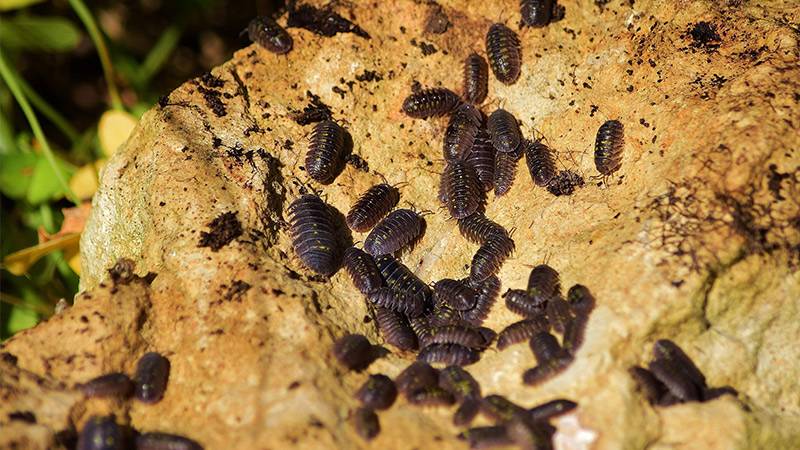Key Takeaways
- Diverse Ecosystem: Composting involves a complex ecosystem with various creatures, each playing a specific role. Helpful critters like red worms and soldier flies speed up composting, while others, like ants and centipedes, might slow it down.
- Moisture and Balance Matter: The presence and concentration of different bugs can indicate the health and conditions of the compost pile, such as moisture levels and nutrient balance Too many pill bugs? It might be too wet. Ants hanging around? Maybe it's too dry.
- Role of Predators: Predatory bugs like spiders and centipedes help control the population of other insects in the compost, but their presence should be carefully monitored as they can also prey on beneficial decomposers. Regularly turning the compost can help maintain a healthier balance of these creatures.
Did you know that composting isn’t just about decaying leaves and kitchen scraps? There’s an entire ecosystem bustling beneath the surface.
If you’ve noticed little creatures wriggling or crawling in your compost heap, don’t be alarmed! These bugs play vital roles in decomposition.
This guide is here to provide a comforting hand on your composting journey, helping you differentiate between the good and the bad bugs in compost, understand their purpose, and guide you on managing them effectively.
The Good Bugs: Compost's Little Helpers
Meet the tiny superheroes of compost: the beneficial bugs. They munch on decomposing matter, breaking it down faster and more effectively than any compost accelerator could.
From the roly-poly pill bugs to the tireless red worms, these critters play a pivotal role in turning your kitchen scraps into nutrient-rich compost.
Pill bugs and sowbugs
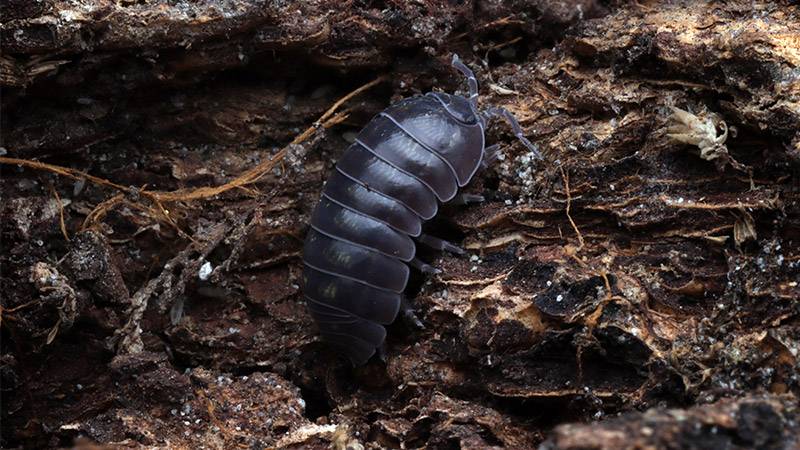
Pill bugs (roly-polies) and sowbugs are fascinating organisms belonging to the isopod order. Appearing similar to tiny armadillos, these creatures are not insects but land-dwelling crustaceans, closely related to shrimp and crabs, and common throughout North America.
Their love for feasting on decaying matter places them front and center in the composting process.
Because they breathe through gills, pill bugs and sowbugs need constant moisture. A high concentration of these bugs may indicate elevated moisture levels in your compost heap.
Their role in breaking down organic material enhances the nutrient value of your compost, converting your waste into a rich resource for plant growth.
Predaceous ground beetles, rove beetles, and white grubs
Predaceous ground beetles and rove beetles are two types of nocturnal hunters that play a crucial role in your compost pile’s biological activity.
These dark-colored beetles, often with hard, ridged wing covers, feast on slugs, worms, insect larvae, and other critters. Their presence indicates a thriving ecosystem teeming with active decomposers they feed on.
On the other hand, white grubs are larvae of beetles from the scarab family. They feed primarily on the roots of discarded plants. Spotting a few in your compost is a sign of a healthy compost ecosystem and won’t negatively influence the pile.
Their existence in the compost pile might seem unexpected, but they contribute to breaking down plant matter, further promoting decomposition.
Red worms
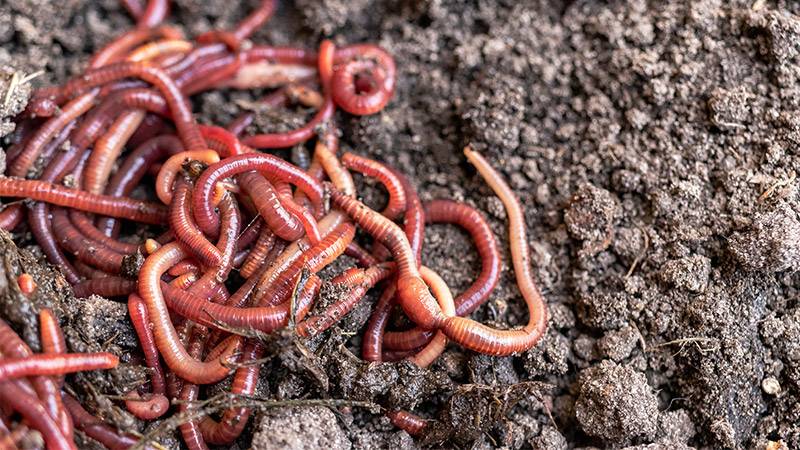
Red worms, also known as “red wigglers,” are essential members of your compost ecosystem. Their preferred diet of kitchen and garden waste, and remarkable temperature tolerance, make them excellent compost helpers.
Unlike their earthworm cousins, who are more suited to soil nutrition and may struggle with the heat of compost bins, red worms thrive in this environment. Their tunneling activity promotes air and water circulation, enhancing the decomposition process.
Their most prized contribution, however, is vermicast — a potent natural fertilizer. Rich in nitrogen, bacteria, and organic matter, these “worm castings” surpass the nutritional content of their original diet.
If nurtured, just a handful of these worms can multiply into a robust worm farm, enriching your compost continually.
Soldier flies
Soldier flies, particularly the commonly found black soldier fly, are nature’s efficient decomposers, making them a welcome presence in your compost bin. They look similar to houseflies, but their affinity for compost piles sets them apart.
Their life cycle begins when they lay eggs on high-nitrogen scraps or rotting food waste within the compost. As their cream-colored, segmented larvae develop, they assist in breaking down organic material, speeding up the composting process.
However, these flies might compete with worms for food, emphasizing the need for balance. If they become too numerous, adding carbon-rich brown ingredients can deter them.
Mites in the pile also help by reducing fly larvae numbers.
Slugs
Slugs, terrestrial mollusks found throughout North America, glide on a layer of protective mucus and are beneficial organisms in your compost bin. Recognizable by their tiny teeth-like structures used to shred food, they play a significant role in the decomposition process of organic matter.
The presence of slugs, especially in the early stages, is a sign of a moist environment suitable for composting. However, an overabundance might indicate excessively moist conditions.
To remedy this, incorporate more carbon-rich brown ingredients into your compost pile such as autumn leaves, straw, or shredded newspapers.
Keep in mind that their role in your compost system is valuable for achieving nutrient-rich compost.
Millipedes

Millipedes are a gardener’s friend. Comprising of ringlike body segments and two pairs of legs per segment, they play an essential role in composting by breaking down organic matter and creating tunnels for microbes to move around the pile.
These round-bodied creatures primarily feed on decaying plant matter, aiding the decomposition process.
When disturbed, they often curl up into a tight spiral, a behavior distinct from their predatory counterpart, the centipede.
Although they need a damp environment, a large number of millipedes could indicate excessive moisture in your compost pile. Adjust the moisture levels to ensure a balanced ecosystem in your compost heap.
Mites

Mites are tiny arthropods that play a crucial part in composting, contributing to the breakdown of organic matter. These organisms are so small that you may need a magnifying glass to spot them in your compost pile.
Despite their size, mites are mighty decomposers, feeding on a variety of materials, including fungi, bacteria, and plant matter. Their diverse diet helps speed up the composting process and enhances the nutrient richness of the compost.
They also help regulate populations of other compost dwellers like fly larvae.
However, an abundance of mites may indicate overly wet conditions in your compost pile, requiring adjustments in moisture levels.
The Bad Bugs: Unwanted Compost Dwellers
While many bugs are beneficial for your compost pile, some are less desirable, disrupting the composting process or posing risks to your garden.
This section introduces those unwanted compost dwellers, explaining why they appear in your compost, their potential harm, and how to deter these nuisances to ensure a healthy composting environment.
Ants
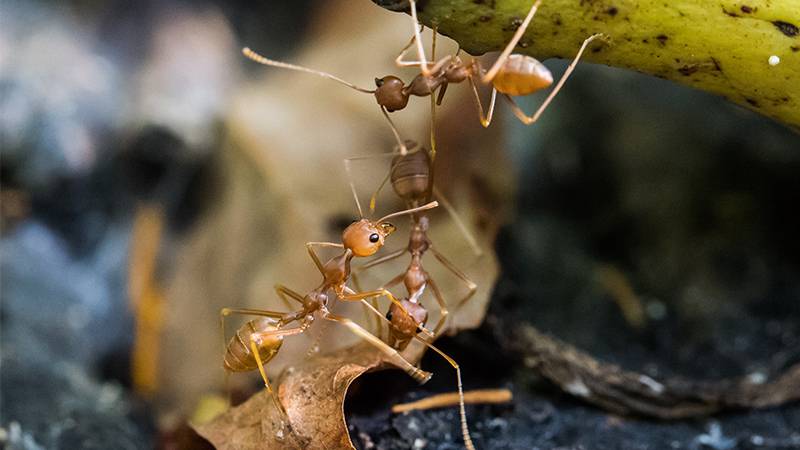
Ants, with their diverse food preferences, are a ubiquitous part of many ecosystems, contributing to soil aeration and biodiversity by introducing beneficial microorganisms. However, they can detrimentally affect your compost pile.
Ants prefer dry soil for nesting and their presence often signals an excessively dry compost pile.
Moreover, ants, especially fire ants, can disrupt the delicate balance by competing with or attacking beneficial worms.
They also transport nutrients away, potentially reducing the compost’s phosphorus and potassium content.
Regular turning of the compost pile and maintaining adequate moisture — similar to a wrung-out sponge — can discourage ant colonization and ensure a healthier compost.
House flies
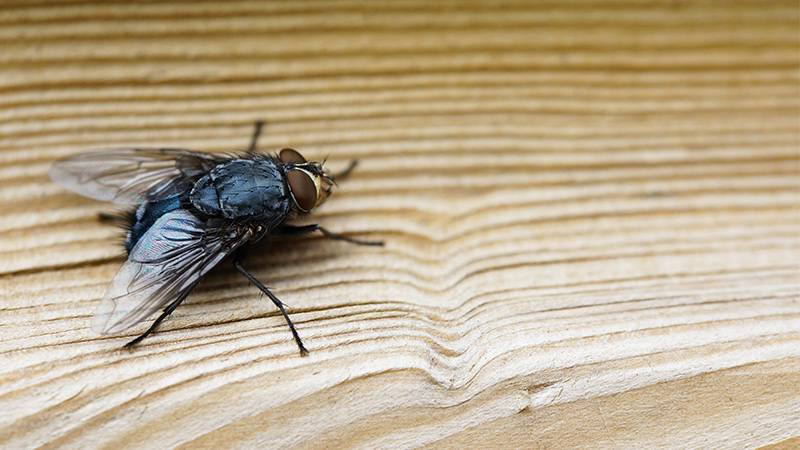
House flies, prevalent pests, can become a nuisance in your compost pile, especially when it’s out of balance. They lay their larvae in the pile, which is not only unsightly but can disrupt the composting process.
These carrion-eating species thrive in compost piles rich in nitrogen “green” matter but lacking sufficient carbon “brown” matter. Prevent their invasion by maintaining a healthy balance of green and brown materials.
Moreover, properly bury your kitchen scraps at least 6-8 inches deep, and refrain from adding meat products to deter these unwanted guests.
Should the pile get too wet, cover it during rainy weeks to help regulate moisture.
Spiders
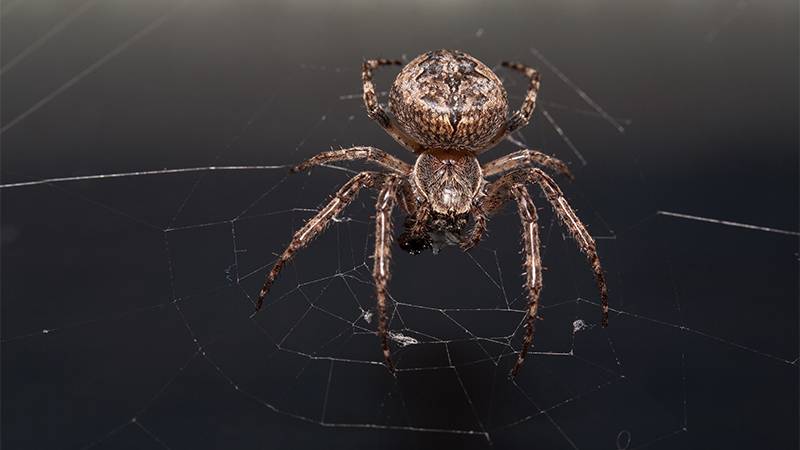
While not necessarily detrimental to the composting process, spiders can be unwelcome guests in your compost pile. These diverse predators, including common cursorial species such as wolf spiders, jumping spiders, and sac spiders, are drawn to the pile in pursuit of prey—often the beneficial bugs aiding in decomposition.
Although spiders play a valuable role in the garden ecosystem by controlling pest populations, their presence in the compost bin signals a high concentration of their prey. Regularly turning the pile can discourage web builders and maintain a healthier bug balance within your compost.
Centipedes
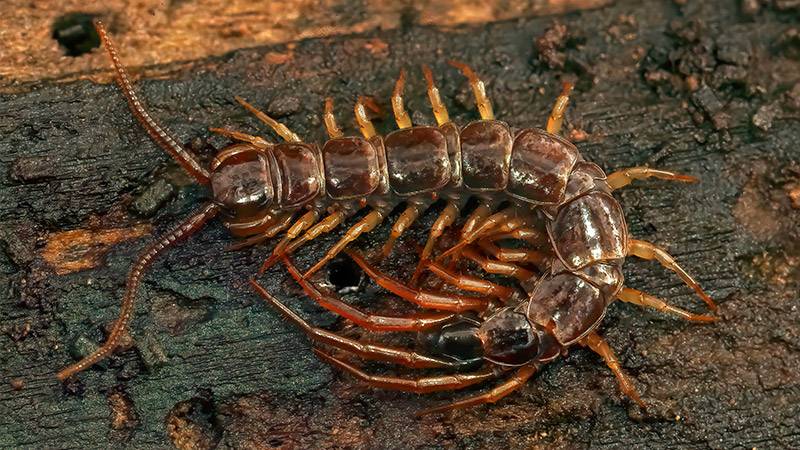
Centipedes are fast movers, often reddish-orange, with one pair of legs per body segment. They frequent both wet and dry compost piles.
Centipedes feed on beneficial insects during the decomposition process, potentially negating their contribution to breaking down organic matter.
As predators, they have poison-infused claws for stinging prey. These aren’t generally strong enough to pierce human flesh, but they may still cause discomfort.
To manage their presence, ensure your compost isn’t overly wet, as they lack a waxy covering for moisture retention.
Regularly turning your compost can also discourage centipedes and maintain a healthier compost balance.
Cockroaches
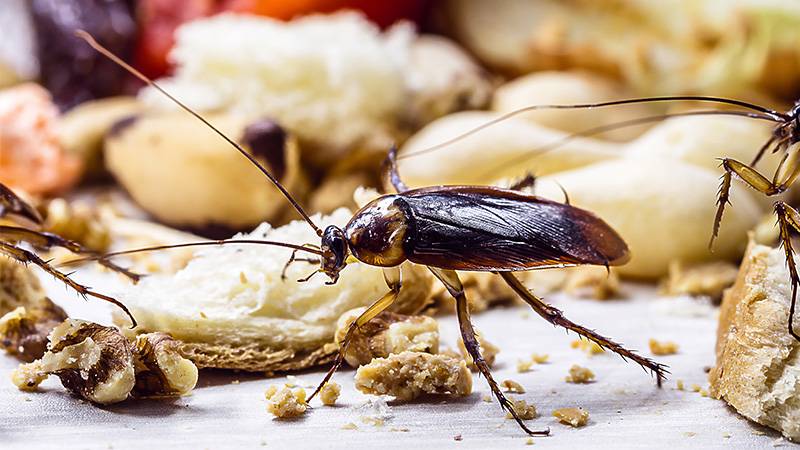
Despite their reputation, cockroaches can play a beneficial role as recyclers in the composting process, breaking down matter into rich compost. However, their presence around home is often an unnerving sight, especially when they are drawn to warm compost bins during the winter.
Although not a cause for concern in terms of compost quality, seeing a cockroach warrants actions like maintaining a good distance between your house and the compost bin.
Their love for the smell of rotting food suggests that a well-balanced pile, free from meat, grease, and dairy, won’t be as attractive to them, effectively mitigating a potential cockroach infestation.
Yellowjackets
Yellowjackets, a type of wasp, are recognized for their distinctive black and yellow markings. While they contribute to natural pest control by feeding on other insects, in a composting context, they can become problematic.
These wasps are attracted to compost bins, especially ones containing fruit scraps, and can build nests near or in the compost pile. Their stings can pose a risk to composters.
To deter yellowjackets, ensure that the compost pile doesn’t become too dry or contain excessive amounts of sweet, rotting fruit.
Covering your compost and regular turning can also help prevent these wasps from becoming a nuisance.
Snakes, mice, rats, possums, and raccoons
Bugs aren’t the only creatures that can get attracted to your compost. Snakes, mice, rats, possums, and raccoons might get drawn to it as well — so you also need to know how you can deter them.
Snakes
Snakes, revered and feared in equal measure, are long, legless, carnivorous reptiles with an often unfounded reputation as compost invaders.
Unlike common perception, their presence in compost bins isn’t innately negative but is a sign of a rodent problem nearby. They primarily show up if rats and mice, their preferred food source, are around.
Gardeners spotting snakes should be alert to a bigger issue — a burgeoning rodent population.
Although snakes don’t harm the composting process, they can create an uncomfortable gardening environment. Regularly turning compost and maintaining a rodent-free compost area can effectively deter these legless visitors and solve the associated problems.
Mice and rats
Mice and rats, on the other hand, are common rodents found around residential areas, recognizable by their long tails and sharp incisors. They are attracted to compost piles due to the readily available food source in the form of kitchen scraps.
The presence of these pests in your compost can be problematic as they could carry diseases, cause structural damage, and become a nuisance.
To prevent them from invading your compost pile, turn your pile more frequently and bury your food waste deeply within the pile.
Using traps can help control an existing infestation. For persistent issues, consider investing in rodent-resistant bins to safeguard your compost from these unwelcome visitors.
Possums and raccoons
Possums and raccoons are small mammals known for their adaptability to urban and suburban environments.
While they do not harm the composting process per se, their attraction to food scraps can create disturbances in your compost pile, potentially leading to a messy situation. They are particularly enticed by eggshells, fresh corncobs, dairy products, and meats.
To prevent these night-time visitors, consider turning your pile more frequently and burying food scraps deep within.
Alternatively, using rodent-resistant bins or lining your compost container with wire mesh can deter their curiosity. A weighted lid can also act as an effective deterrent.

Read More:
Conclusion
Understanding the roles of various creatures in your compost, including bugs, can be an empowering part of your composting journey. From worms to spiders, ants to centipedes, each has a unique part to play, sometimes beneficial, at times harmful.
Knowledge of these creatures and how to manage their populations is critical to maintaining a healthy, productive compost pile. So, don’t let the presence of a few uninvited guests discourage you. Continue to compost, keep a keen eye on your pile’s inhabitants, and let nature do the rest.

